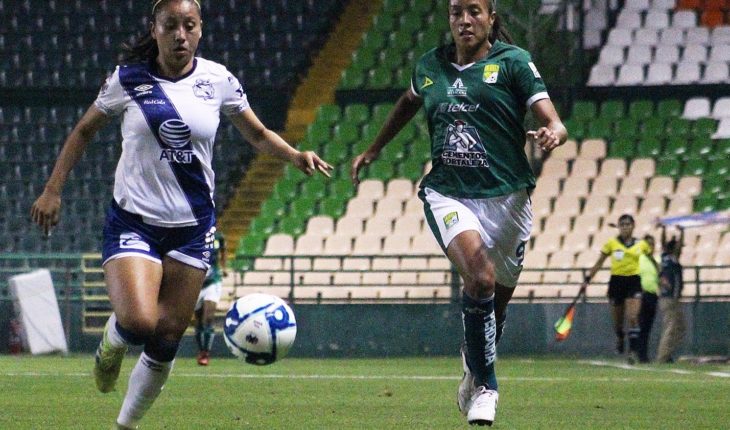Nearly three years after its inception, women’s MX League players have signalled their battle against low wages, inequality and other deficiencies, but also mention that it is a growing league, which with the support of the people can advance a positive path for women, ‘beating’ to gender stereotypes and stigmas.
Currently in the Liga MX Women’s there are 18 teams and about 530 players are registered. That number of teams is higher than there are in France (12 sets compete), and that of the one in the United States (there are 9 clubs).
Read more: Low wages, inequality and machismo, footballers’ rivals in Mexico
Women’s football in Mexico has been gaining spaces, dissemination and interest among people, the players and sports commentators consulted for this report coincide. However, there is still a need to turn that into a better professional development.
“You can complain about wages and working conditions, but in everything, in the little that goes compared to the European leagues, the Liga MX Femenil has rescatable things like the use of stadiums in some teams (women play matches in the same stadiums as men) and the presence of the fans in them,” says Ana Paola López, Pachuca player.
The front of the Tuzas says that, a few months ago, a board of Inter Milan women who visited Hidalguense lands was said astonished after seeing the amount of hobby that attends the stadium. He told her that you don’t see that in Italy, as people don’t care about women’s football.
“There are several things to complain about, but it’s also true that somehow the league isn’t going as bad,” adds Ana Paola.
Geo González, a commentator for the TUDN network, says that even people from countries like Australia, whose women’s team is a world power, have asked about the strategy implemented in Mexico, since their league “does not come close at all to ours, which is stronger and stronger”.
A developing “industry”
As for salaries, one of the main outstanding issues, Gonzalez believes that the debate should focus, at the outset, on require players to earn income that allows them to live in a dignified manner, for their professional activity.
At the moment, he points out, women cannot be expected to earn the same as men, because “women’s football is not as industrialized as manly.”
In addition to the above, Pachuca’s goalscorer Ana Paola López believes that it would be important to consolidate the project of basic forces, in order for the players to reach professionalism with several years of preparation.
“It has been thought about putting up schools for girls, but they depend on the club (…) few teams are developing serious projects of seedlings of players, because unfortunately for most clubs the women’s team is still a drag.”
Find out: Mexico has the worst wage gap in the region, women work harder than men and earn less
Cheyli Almejo, a former player from Veracruz, recognizes the work that has been done in some teams, such as Pachuca and Chivas, in terms of the investment and preparation of the players, and hopes that in the future other sets will follow his example, to equalize the level of competitiveness.
Journalist Marion Reimers believes that although the growth has been remarkable so far, the tournament level will not prosper if only a few teams invest, and the rest do not, for machismo or lack of vision.
“All right, women’s football is a developing industry, it’s a business that gives and can grow, a business that in Mexico has already given the first indications that it may be something very important, but unfortunately there is a great resistance to change and advancement, and the root of that is machismo,” he says.
Reimers adds that the proof that the Liga MX Femenil is on the rise is that other countries, such as Spain and the United States, have turned to see her for her football and hobby growth. “So all it takes is to expose those who continue to resist investing, and to grow this project.”
Promise of growth
The president of liga MX, Enrique Bonilla, augurs a good future for the Women’s League and accepts that in the time it has been developed at a speed that they did not expect.
Bonilla highlights the impact it has had on the hobby.
As an example, he mentions the attendance of fans at the final of the 2019 Apertura between Tigres and Monterrey, which was 38,000 fans, “an amount that does not register even in the best leagues”.
The 38,000 fans at the Tigres vs. Monterrey far surpass the 10,227 spectators who witnessed, on October 27, 2019, the final, the National Women’s Soccer League (NWSL), of the United States, between North Carolina Courage and Chicago Red Stars.
The attendance figure for matches in Mexico is available week after week on the Liga MX Femenil page. So far from the Clausura 2020, with two days played, the total attendance for the matches has been 32 thousand 076 fans. The team with the highest attendance was Club Atlético de San Luis, with 3 thousand 487 and 5 thousand 890 fans in their first two matches.
Tuzas player Ana Paola Lopez believes attendance would be higher if matches were more accessible to the fans, as weekend opening times and stellar days are reserved for men. In addition, Ana Paola asks that there be broadcast of the matches on open television, and that they are not only by cable, as before.
Although it did not give specific figures Geo González, from TUDN, it points out that the Rating of the Mx Women’s League has been maintained or improved tournament after tournament, even though the schedules are sometimes complicated.
According to the commentator, the best records have been held in the Liguilla games.
“It also depends a lot on the match being played (…) now Monday has become the day of women’s football and the fans are already recognizing what the interesting games are (…) it’s a project that is intended to continue supporting, because the teams offer a good rhythm and intensity and ends up being an entertaining show that catches the fan,” Geo says.
Projects
On the part of the Liga MX there are several projects to consolidate in the coming years, to boost the growth of the players. One of them is the commitment of the Center for Technological Innovation of the Mexican Football Federation, to provide them with the same technological tools as men, starting this January.
“We’re already going to use telemetry systems, as well as the vests men use to measure distances they travel and other tools to record their physical performance. All that information will be uploaded to a platform to make them known worldwide,” says Bonilla, president of Liga MX.
Another measure is that, last December, club owners agreed that for the 2020-2021 season each institution must have its U-17 women’s team.
“These tell us that it will be invested in the clubs, they will have much more prepared players physically and tactically, and this in the long run is going to be a benefit for Mexican football.”
According to Bonilla, when this tournament ends, the players who started the project three years ago will be consolidated, and added to the start of the U-17 category, the league will be strengthened and there will be more competition.
Bonilla says that since the first tournament the Liga MX gave due importance to the women’s category. The appointment last August of Mariana Gutiérrez as director of the Liga stands out.
To this day, Mariana is responsible for coordinating all the logistics of the League, monitoring the correct use of the budget and deciding the actions that promote the growth of the same.
For her part, the CEO of Chivas women’s, Nelly Simón, says that the main objective of her institution is to professionalize the players, and not only to be superior to other teams, but to try to be an example that is emulated by the rest of the clubs.
“The most important thing for us is to train the players as human beings, with the vision and values of Chivas, and then as footballers.”
Nelly points out that professionalization will eventually achieve a level playing field, relative to men.
Having been the first woman to hold a managerial position at a club, Nelly hopes her case will open the door to many other women, who have the capacity to hold these positions.
He accepts that, although people from other countries have expressed their astonishment at the growth of the Women’s League, there is still a long way to go, especially at the football level, and that this will only be possible with the professionalization of the players and the preparation from an early age.
If these objectives are met, he says, the Liga MX Femenil has a great chance of consolidating in the long term and, above all, giving fair treatment to the players.
What we do in Animal Político requires professional journalists, teamwork, dialogue with readers and something very important: independence. You can help us keep going. Be part of the team.
Subscribe to Animal Politician, receive benefits and support free journalism.#YoSoyAnimal
translated from Spanish: MX Women’s League players in search of equity
January 17, 2020 |





